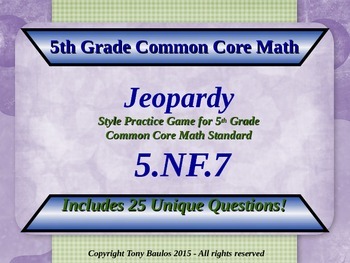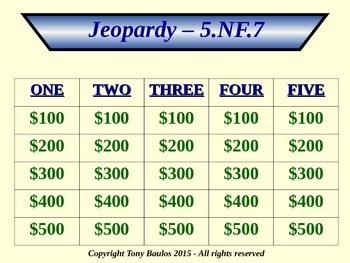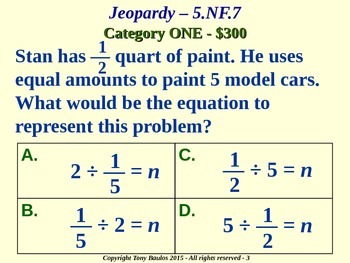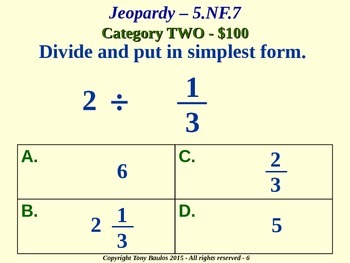5.NF.7 5th Grade Math Jeopardy Divide Fractions by Whole Numbers Google Slides
- Zip
- Google Apps™

What educators are saying
Description
Fifth Grade Common Core Math Jeopardy Game - 5 NF.7 Divide Unit Fractions by Whole Numbers 5.NF.7 Practice provides two ways for students to practice and show mastery of their ability to divide unit fractions by whole numbers and whole numbers by unit fractions. 5.NF.B.7 5.NF.B.7a 5.NF.B.7b 5.NF.B.7c
Jeopardy board includes 25 distinct problems and utilizes hyperlinks to award/deduct money from your student teams! (79 slides in all!) Board is automatically updated to show which questions have already been utilized. Also includes an Answer Key if you wish to use questions as Quiz/Test. The PowerPoint file can be used on computers, or Promethean and Smart boards.
Now includes a Google Slides TM version in addition to the original PowerPoint!
Take a look at the preview file and buy today for your students benefit!
Standard 5.NF.7 Apply and extend previous understandings of multiplication and division to multiply and divide fractions.
Apply and extend previous understandings of division to divide unit
fractions by whole numbers and whole numbers by unit fractions.
a. Interpret division of a unit fraction by a non-zero whole number, and compute such quotients. For example, create a story context
for (1/3) ÷ 4, and use a visual fraction model to show the quotient.
Use the relationship between multiplication and division to explain
that (1/3) ÷ 4 = 1/12 because (1/12) × 4 = 1/3.
b. Interpret division of a whole number by a unit fraction, and
compute such quotients. For example, create a story context for
4 ÷ (1/5), and use a visual fraction model to show the quotient. Use
the relationship between multiplication and division to explain that
4 ÷ (1/5) = 20 because 20 × (1/5) = 4.
c. Solve real world problems involving division of unit fractions by
non-zero whole numbers and division of whole numbers by unit
fractions, e.g., by using visual fraction models and equations to
represent the problem. For example, how much chocolate will each
person get if 3 people share 1/2 lb of chocolate equally? How many
1/3-cup servings are in 2 cups of raisins?





